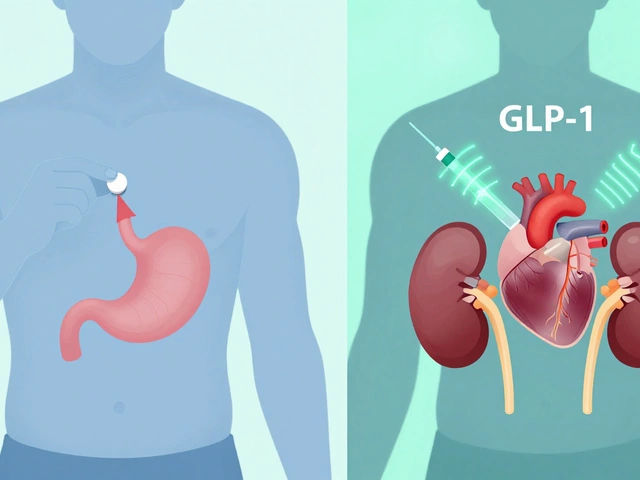Metformin is pretty much the first pill doctors reach for when you get diagnosed with type 2 diabetes. But wow—ask anyone who’s taken it, and you’ll hear crowds of complaints. Stomach pain, bathroom emergencies, feeling blah—it’s not exactly the dream fix for high blood sugar. So why do so many people stick with it, and why do others swear they’ll never touch it again?
Here's what’s real: metformin works, but the side effects hit hard for a lot of folks. The stories about urgent dashes to the bathroom or feeling queasy aren’t made up. It’s the classic love-hate medication in the diabetes world. And while the worst problems usually show up in the first few weeks, for some people, things never settle down.
If you just got handed a script for metformin, you’re probably wondering what you’re in for—and if there’s anything you can do to dodge the nastier side effects. I'll break down exactly why metformin turns some people’s lives upside down, who actually shouldn’t even try it, and what simple tricks can make it a little less rough on your system.
- What Metformin Actually Does
- Common Side Effects That Annoy People
- Long-Term Concerns and Rare Risks
- Who Really Should Avoid Metformin?
- Practical Tips to Survive (or Replace) Metformin
What Metformin Actually Does
Metformin is what doctors call a “first-line” medication for type 2 diabetes, but what does it really do in your body? Here’s the plain truth: it helps your body use its own insulin more effectively. It mostly works by lowering the amount of sugar your liver pumps out into your blood—basically, it stops your liver from acting like a sugar factory gone wild. At the same time, it helps your body’s cells soak up more sugar from your blood so your sugar levels stay steady after you eat. The result? Less sugar floating around in your blood, which is exactly what you want when you have diabetes.
Metformin doesn’t make your pancreas produce more insulin, and it doesn’t usually make your blood sugar drop dangerously low (which is called hypoglycemia). That separates it from a lot of other diabetes pills out there that can leave you with sudden sugar crashes.
- Metformin is usually taken once or twice a day, with meals to help avoid stomach problems.
- It comes as a tablet or extended-release version (which is easier on the stomach for some people).
- Doctors sometimes use it “off-label” for things other than diabetes, like polycystic ovary syndrome (PCOS), because it helps with insulin resistance.
Check out these basic facts about how metformin compares to other diabetes meds:
| Drug | Dose Frequency | Chance of Low Blood Sugar | Common Use |
|---|---|---|---|
| Metformin | 1-2 times/day | Rarely causes | Type 2 Diabetes, PCOS |
| Sulfonylureas | 1-2 times/day | Common | Type 2 Diabetes |
| Insulin | Varies | Very common | Type 1 & 2 Diabetes |
Most people see a drop in their blood sugar numbers within a couple weeks of starting metformin. Studies show on average, people using metformin can see their A1C (that’s your three-month average blood sugar) drop by about 1%—not bad for a pill that’s been around since the 1950s. That’s a big reason why it remains the go-to drug for doctors all over the world.
Common Side Effects That Annoy People
The truth is, most of the complaints about metformin come down to what it does to your gut. If you ask around in any diabetes support group, GI (gastrointestinal) problems are what people bring up first. It's no joke—these side effects are so classic, doctors actually warn you about them before you even start.
Here's a breakdown of the stuff that annoys people the most:
- Diarrhea: Easily the most reported problem. For some, it hits fast and doesn’t let up. Others get lucky and it eases after the first week or two.
- Nausea and upset stomach: That queasy, unsettled feeling is super common, especially right after you take the pill.
- Gas and bloating: Some folks describe it as feeling like a balloon about to pop. Awkward, painful, and tough to hide at work or in public.
- Metallic taste in your mouth: Less common, but it creeps up for a handful of people and makes food taste weird.
- Loss of appetite: For a few, metformin kills hunger. That might sound good if you’re trying to lose weight, but it’s not so fun if you already struggle to eat.
Most side effects kick in as soon as you start or when your dose goes up. The good news: for a lot of people, things settle down in about two to four weeks. But there’s a stubborn group—roughly 5 to 10%—who never really adjust.
Here’s a quick look at how common these side effects really are:
| Side Effect | How Many Get It (%) |
|---|---|
| Diarrhea | 20-25% |
| Stomach pain/upset | 7-13% |
| Nausea/vomiting | 7-26% |
| Gas/bloating | 5-12% |
| Metallic taste | 3-5% |
One tip—if your doctor says to go slow and take metformin with food, it’s not just a suggestion. That really can make the difference between having a manageable first month and hating your life. There’s even an extended-release (ER) version that’s much easier on the gut for many people. Bottom line: if the side effects are making you miserable, don’t just tough it out. Talk to your doctor about dosing, timing, or switching to ER. You’ve got options.

Long-Term Concerns and Rare Risks
Long-term use of metformin brings up a couple of big worries for people with diabetes. The main thing you’ll hear doctors talk about is vitamin B12 deficiency. Metformin can make it harder for your gut to absorb B12. A huge study from Canada back in 2016 found that up to 20% of long-term metformin users had lower B12 levels than normal. Low B12 can creep up on you—causing tiredness, brain fog, and even nerve problems if things get bad enough.
It’s also smart to know about lactic acidosis. This is a super rare side effect, but it’s serious. Lactic acidosis happens when acid builds up in the blood. The risk is tiny—about three cases per 100,000 patients each year. But if you’ve got bad kidney problems or severe liver issues, the odds get higher, and doctors often tell folks in that group to avoid metformin entirely.
Some people also worry about metformin messing with hormones or causing other long-term trouble, like memory issues. But aside from B12 and lactic acidosis, science hasn’t found much else to worry about for most people. There’s even some early research hinting that metformin might lower your risk for certain cancers, but those studies are still ongoing and not a reason to start popping pills.
- Get blood work for vitamin B12 once a year if you’re taking metformin long term.
- If you notice nerve pain, weakness, or tiredness lasting for weeks, ask your doc about testing B12.
- Don’t take metformin if you have serious kidney or liver disease—ask about other meds.
- If you ever get short of breath, chest pain, or super weak, see a doctor and mention you’re on metformin.
Here’s a quick look at what the numbers actually show about long-term risks:
| Risk | How Often It Happens | Who’s at Risk |
|---|---|---|
| B12 Deficiency | Up to 20% of users over several years | All metformin users, risk rises with age |
| Lactic Acidosis | About 3 per 100,000 users per year | Those with kidney or liver disease |
| Memory Issues | Not proven in big studies | Still under research |
| Hormone Trouble | No strong evidence | Still being studied |
If you’re on metformin and feeling fine, that’s great—just ask your provider to check your B12 every so often. And don’t stress too much about the rare stuff if your kidneys and liver are healthy. Most people never deal with these problems, but knowing the facts means you’re less likely to get blindsided.
Who Really Should Avoid Metformin?
This pill works for a ton of people, but there are clear cases where you shouldn’t even go near it. Some health conditions make taking metformin flat-out risky—sometimes dangerous enough to land you in the hospital. Here’s a straightforward look at who should say no to metformin, no matter what.
First up: people with serious kidney problems. Metformin leaves your body through your kidneys, so if your kidneys aren't working right, the drug can build up in your blood. Worst case, it leads to a rare but scary condition called lactic acidosis—basically, acid poisoning of your blood. One study found this happens to less than 0.1% of users, but it’s not a risk you want to play with.
Here’s a quick cross-section of conditions where metformin is generally off the table:
- Advanced kidney disease (eGFR less than 30 mL/min/1.73 m²)
- Severe liver problems—your liver helps clear acids, and if that fails, acid can build up
- Drinking large amounts of alcohol regularly (alcohol plus metformin = acid overload risk)
- Heart failure that’s not stable (especially if you’ve been in the hospital for it)
There are also situations where your doctor might tell you to pause metformin—like right before major surgery, or when you’re getting certain X-ray scans with dye. That’s because these stress your kidneys, even for a day or two, and can make metformin dangerous until you recover.
| Condition | Why It’s a Problem |
|---|---|
| Advanced Kidney Disease | Risk of lactic acidosis because metformin can’t be cleared |
| Severe Liver Disease | Liver can’t clear acids, increasing toxicity |
| Heavy Alcohol Use | Alcohol stresses liver and kidneys, multiplying acid risk |
| Unstable Heart Failure | Poor circulation slows drug removal |
Kidney issues are easily the most common reason doctors say no to metformin, but the others do matter. If you fit into one of these groups, be straight with your doctor and push for a different diabetes medication. No pill is worth risking your life.

Practical Tips to Survive (or Replace) Metformin
If you’re stuck with metformin and thinking “There must be a better way,” you’re not alone. Here’s what you can actually do to deal with the chaos the pill sometimes brings to your daily life.
- Metformin almost always hits the digestive system first. If you’re new to it, start low and go slow. Doctors often suggest starting with 500 mg once a day, then bumping it up slowly. This gives your stomach a fighting chance to chill out.
- Don’t take it on an empty stomach. Pop it with dinner or, if you take it twice a day, with breakfast and dinner. Food helps keep the nausea and cramps in check.
- If regular metformin is making you miserable, ask for the extended-release (ER) version. It’s proven to cause way fewer stomach problems for most people.
- Tired of the pill shape and size? Ask your pharmacist if there’s a different generic, or even a liquid, which is sometimes easier on the gut.
- Track your symptoms for a couple of weeks. Note when you’re having trouble, what you ate, and how quickly symptoms hit. This helps your doctor figure out if things will settle or if you’re just not a good fit for this drug.
But—sometimes, metformin just isn’t the move. If you have kidney problems, bad liver numbers, or keep getting super low B12, it’s time to chat seriously with your doctor about alternatives. There are plenty of other diabetes pills and even once-a-week injections like GLP-1 drugs that don’t wreck your stomach.
Don’t suffer in silence. It’s your body and you have every right to push for a treatment plan that actually lets you function—without living in the bathroom or battling side effects that just aren’t worth it.





